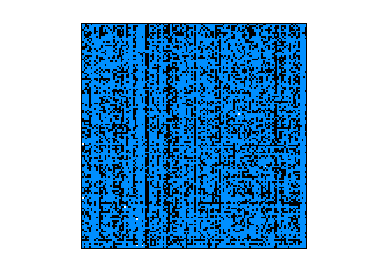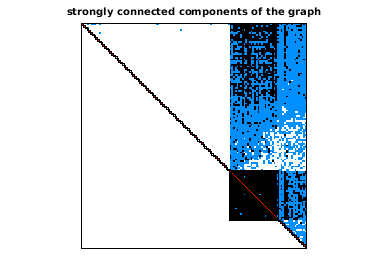SNAP (Stanford Network Analysis Platform) Large Network Dataset Collection,
Jure Leskovec and Anrej Krevl, http://snap.stanford.edu/data, June 2014.
email: jure at cs.stanford.edu
Wikipedia Requests for Adminship (with text)
https://snap.stanford.edu/data/wiki-RfA.html
Dataset information
For a Wikipedia editor to become an administrator, a request for adminship
(RfA) (http://en.wikipedia.org/wiki/Wikipedia:RfA) must be submitted,
either by the candidate or by another community member. Subsequently, any
Wikipedia member may cast a supporting, neutral, or opposing vote.
We crawled and parsed all votes since the adoption of the RfA process in
2003 through May 2013. The dataset contains 11,381 users (voters and
votees) forming 189,004 distinct voter/votee pairs, for a total of 198,275
votes (this is larger than the number of distinct voter/votee pairs
because, if the same user ran for election several times, the same
voter/votee pair may contribute several votes).
This induces a directed, signed network in which nodes represent Wikipedia
members and edges represent votes. In this sense, the present dataset is a
more recent version of the Wikipedia adminship election data
(https://snap.stanford.edu/data/wiki-Elec.html). However, there is also a
rich textual component in RfAs, which was not included in the older
version: each vote is typically accompanied by a short comment
(median/mean: 19/34 tokens). A typical positive comment reads, "I've no
concerns, will make an excellent addition to the admin corps", while an
example of a negative comment is, "Little evidence of collaboration with
other editors and limited content creation."
Network statistics
Nodes 10,835
Edges 159,388
Triangles 956,428
[The above statistics were computed after transforming the data into a
directed network. The number of edges (159,388) is smaller than the number
of voter/votee pairs (189,004) because neutral votes were discarded in the
network we used for computing the statistics (but they are included in the
dataset).]
Sources (citations)
Robert West, Hristo S. Paskov, Jure Leskovec, and Christopher Potts:
Exploiting Social Network Structure for Person-to-Person Sentiment
Analysis. Transactions of the Association for Computational Linguistics,
2(Oct):297–310, 2014. http://infolab.stanford.edu/~west1/pubs/
West-Paskov-Leskovec-Potts_TACL-14.pdf
Files
File Description
wiki-RfA.txt.gz Wikipedia Requests for Adminship (RfA) 2003–2013
Data format
SRC:Guettarda
TGT:Lord Roem
VOT:1
RES:1
YEA:2013
DAT:19:53, 25 January 2013
TXT:'''Support''' per [[WP:DEAL]]: clueful,
and unlikely to break Wikipedia.
where entries are separated by a single empty line and
SRC: user name of source, i.e., voter
TGT: user name of target, i.e., the user running for election
VOT: the source's vote on the target
(-1 = oppose; 0 = neutral; 1 = support)
RES: the outcome of the election
(-1 = target was rejected as admin; 1 = target was accepted)
YEA: the year in which the election was started
DAT: the date and time of this vote
TXT: the comment written by the source, in wiki markup
---------------------------------------------------------------------------
Notes on inclusion into the SuiteSparse Matrix Collection, July 2018:
---------------------------------------------------------------------------
In the SuiteSparse Matrix Collection, the 6 data items are split into
6 different arrays in the MATLAB struct, and 6 different files in the
MatrixMarket and Rutherford-Boeing formats. Each have 198,275 rows
(one per vote). The votes appear in the same order as they do in the
wiki-Rfa.txt file in the SNAP data set.
Problem.aux.Source source user name (a string, length <= 48)
Problem.aux.Target target user name
Problem.aux.Vote -1 (oppose), 0 (neutral), or 1 (support)
Problem.aux.Result result of the election (-1:reject, 1:accept)
Problem.aux.Year year of the vote (a number, 2003 to 2013)
Problem.aux.Date time and date (a string: HH:MM, day Month Year)
Problem.aux.Text text of the comments (a string, len <= 7609)
In addition, the user names from the SRC: and TGT: of the votes have been
collected in a single list, of size 11,380, and appear in
Problem.aux.UserId (each of length <= 48). This list of user names has
been sorted alplabetically.
In 1,661 votes, the SRC: field is blank. These votes appear in the aux
fields listed above, but are excluded from the graphs described below.
For these votes, the DAT: and TXT: are also empty. This "user id" is
excluded in the list of user id's, giving 11,380 total users instead
of 11,381.
The user names in Problem.aux.Source and Problem.aux.Target have been
translated into node numbers for the graph, into the two arrays
Problem.aux.SourceNode and Problem.aux.TargetNode. For the kth vote, the
string Source(k,:) is equal to UserId (SourceNode (k),:), and likewise for
the target nodes. For votes with empty SRC: fields, however,
SourceNode(k)=0.
Four graphs are constructed from the votes, after pruning votes with
empty SRC: fields. The primary graph, Problem.A, counts the number of
votes, where A(i,j) is the number of times the ith user voted on the
jth user (either positive, neutral, or negative, regardless of the vote).
Each kind of vote is captured in three graphs. For the source i and
target j:
Problem.aux.Positive (i,j) is the number of VOT:+1 votes that i voted on j
Problem.aux.Neutral (i,j) is the number of VOT:0 (neutral) votes that
i voted on j. Note that a neutral vote is not the same thing as
no vote at all.
Problem.aux.Negative (i,j) is the number of VOT:-1 votes that i voted on j
Thus, each graph is a multigraph, where the value of the (i,j) edge
captures the number of edges, or votes, of the form (i,j) where
i=source and j=target. The overall graph A = Problem.A, is equal
to the sum, A = Positive + Neutral + Negative.
graph A nnz 188077 sum 196614
vote max multiplicity: 6
# votes: 1 : count 180284
# votes: 2 : count 7153
# votes: 3 : count 550
# votes: 4 : count 77
# votes: 5 : count 12
# votes: 6 : count 1
graph Positive nnz 139326 sum 143879
vote max multiplicity: 6
# votes: 1 : count 135128
# votes: 2 : count 3884
# votes: 3 : count 278
# votes: 4 : count 32
# votes: 5 : count 3
# votes: 6 : count 1
graph Neutral nnz 11846 sum 12068
vote max multiplicity: 3
# votes: 1 : count 11627
# votes: 2 : count 216
# votes: 3 : count 3
graph Negative nnz 39206 sum 40667
vote max multiplicity: 5
# votes: 1 : count 37840
# votes: 2 : count 1289
# votes: 3 : count 63
# votes: 4 : count 10
# votes: 5 : count 4
That is, the full graph A includes all 196,614 votes with non-empty SRC:
fields (198275-1661). The graphs do not capture the temporal nature of
the edges; this data is preserved in the votes themselves, in the
Problem.aux.[Source Target Vote Result Year Date Text] components.

